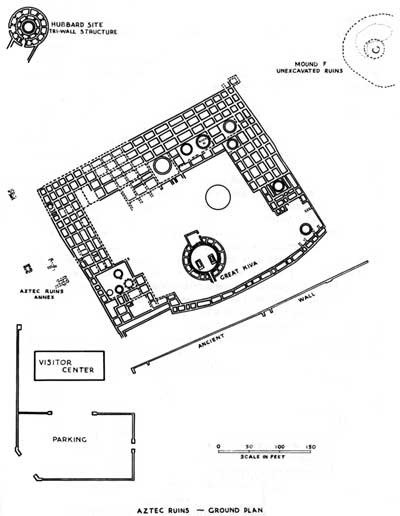|
AZTEC RUINS National Monument |
 |

Aztec Ruins - Ground Plan.
Explorations and Excavations (continued)
The first scientific investigations of the ruins were made in 1878, when Lewis H. Morgan visited the site and later published a description with a good ground plan. Morgan, sometimes known as "the father of American anthropology," was one of the most distinguished scientists of the 19th century. He is well known for his ethnological studies of the Iroquois Indians in New York. Though usually thought of as a "social anthropologist," Morgan had a great and abiding interest in archeology, particularly that of the southwestern part of what is now the United States, Mexico, and Central America. On his trip to the Southwest in 1878, he kept a journal full of observations and notes about the various ruins which he visited.
In those days the railroad extended only to Canyon City, Colo., and from there Morgan and his party had to proceed by wagon. One of the ruins which especially seemed to intrigue Morgan was the one on the Animas River, which we now call Aztec. He not only made a ground plan of the entire ruin, but noted that there were other structures of considerable size and interest in the immediate vicinity. He also entered some of the rooms, particularly in the west wing of the larger ruin, which still had their ceilings intact. Even at that time, evidently a good bit of the ruin had already been destroyed by the early settlers, for Morgan records the fact that one man at Animas City, who had lived near the ruins, told him that about one quarter of the stones had been taken away by the settlers to use in building houses, lining wells, or for other construction purposes. Morgan also talks about entering rooms on the second story, so presumably some of these upper stories may still have been intact in 1878.
In 1892, Warren K. Moorehead visited the Aztec ruins, studied them, and in 1908, he published an article and sketch map in the American Anthropologist. Moorehead is better known for his work among the prehistoric mounds and temples in southeastern United States than for investigations in the Southwest, but he was a competent archeologist and keen observer of prehistoric remains. He and his party, like other early explorers, were evidently able to enter a number of intact rooms—he says, "twenty or thirty apartments."
In 1915, Dr. N. C. Nelson, who was then curator of archeology for the American Museum of Natural History, examined the ruins and was impressed by their potential for further intensive investigations. At this time the museum was undertaking the Archer M. Huntington Survey of the Southwest, one of the objectives of which was to make an intensive study of a large pueblo site. Because of Nelson's recommendations, permission was obtained in 1916, from the owner, H. D. Abrams, to clear it of brush and weeds and to make trial excavations, the expense of this undertaking being borne by J. P. Morgan. As a result of these preliminary investigations the museum decided that complete excavation and repair of the West Ruin was desirable not only for the purpose of procuring data on the culture of its ancient builders, but also, in order that it might be preserved as a permanent exhibit. As a result, the museum engaged the services of Morris, who for the next 5 years devoted his time and attention to very careful excavations of the West Ruin.
However, some 35 years before Morris undertook his excavations an interesting and somewhat fortuitous event occurred at the old ruins that caused them to gain notoriety, at least locally.

|

|
|
Last Modified: Sat, Jan 13 2001 10:00:00 am PDT |


